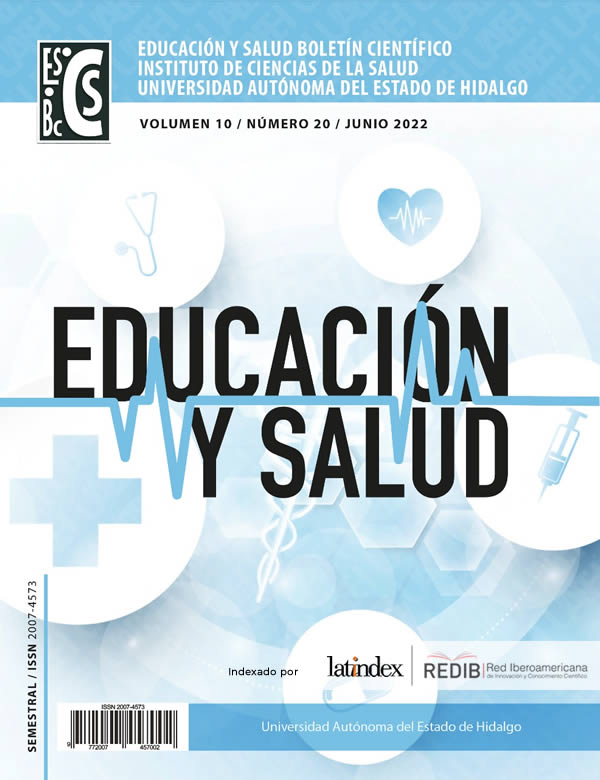Effectiveness of infiltrating resins on non-cavitated caries lesions in enamel: Bibliographic review
Abstract
This review aimed to evaluate the efficacy of resin infiltration in non-cavitated caries lesions and post orthodontic white spot lesions through searching in the PubMed database, up to the year 2020. Fifteen scientific articles were selected, of which 5 analyzed resin infiltration in non-cavitated caries and 10 in post orthodontic lesions; of the evaluation methods used, 6 used spectrophotometry, 4 radiographs, 1 DiagnoDent instrument, 3 intraoral photographs, and 1 grayscale histogram. Resin infiltration was compared with placebo, fluoride varnish, pit and fissure sealants, and it was determined that the use of ICON resin infiltration can immediately stop the progression of the caries lesion.
Downloads
References
Chalmers JM. Minimal intervention dentistry: Part 1. Strategies for addressing the new caries challenge in older patients. J Can Dent Assoc. 2006;72(5):427–33.
Mount GJ, Hume WR. Preservation and restoration of tooth structure. Sandgate, Queensland : Knowledge Books and Software; 2005. 365 p.
Keilbassa AM, Muller J, Gernhardt CR. Closing the gap between oral hygiene and minimally invasive dentistry: a review on the resin infiltration technique of incipient (proximal) enamel lesions. Quintessence Int. 2009;40(8):663–81.
Paris S, Meyer-Lueckel H. Masking of labial enamel white spot lesions by resin infiltration--a clinical report. Quintessence Int. 2009;40(9):713–8.
Tirlet G, Chabouis HF, Attal JP. Infiltration, a new therapy for masking enamel white spots: a 19-month follow-up case series. Eur J Esthet Dent. 2013;8(2):180–90.
Prasada KL, Penta PK, Ramya KM. Spectrophotometric evaluation of white spot lesion treatment using novel resin infiltration material (ICON®). J Conserv Dent. 2018;21(5):531.
Splieth CH, Ekstrand KR, Alkilzy M, Clarkson J, Meyer-Lueckel H, Martignon S, et al. Sealants in dentistry: Outcomes of the ORCA saturday afternoon symposium. Caries Res. 2010;44:3–13.
Marró ML, Cabello R, Rodríguez R, Mustakis A, Urzúa I. Treatment of approximal caries lesions using infiltrants. Rev Clin Periodoncia Implant Rehabil Oral. 2011;4(3):134–7.
Marquezan M, Corrêa FNP, Sanabe ME, Rodrigues Filho LE, Hebling J, Guedes-Pinto AC, et al. Artificial methods of dentine caries induction: A hardness and morphological comparative study. Arch Oral Biol. 2009;54(12):1111–7.
Abdullah Z, John J. Minimally Invasive Treatment of White Spot Lesions-A Systematic Review. Oral Heal Prev Dent. 2016;14(3):197–205.
Paris S, Bitter K, Krois J, Meyer-Lueckel H. Seven-year-efficacy of proximal caries infiltration - Randomized clinical trial. J Dent. 2020;93:103277.
Kannan A, Padmanabhan S. Comparative evaluation of Icon® resin infiltration and ClinproTM XT varnish on colour and fluorescence changes of white spot lesions: a randomized controlled trial. Prog Orthod. 2019;20(1).
Peters MC, Hopkins AR, Zhu L, Yu Q. Efficacy of Proximal Resin Infiltration on Caries Inhibition: Results from a 3-Year Randomized Controlled Clinical Trial. J Dent Res. 2019;98(13):1497–502.
Gu X, Yang L, Yang D, Gao Y, Duan X, Zhu X, et al. Esthetic improvements of postorthodontic white-spot lesions treated with resin infiltration and microabrasion: A split-mouth, randomized clinical trial. Angle Orthod. 2019;89(3):372–7.
Baafif HA, Alibrahim IF, Alotaibi SH, Alharbi HG, Shubaily MN, Elkwatehy WMA. The Efficacy of Resin Infiltrant and Casein Phosphopeptide-amorphous Calcium Fluoride Phosphate in Treatment of White Spot Lesions (Comparative Study). J Int Soc Prev Community Dent. 2020;10(4):438–44.
Andrade RMPM, Lima TO, Menezes-Oliveira MA, Nogueira R, Lepri CP, Geraldo-Martins V. Clinical evaluation of the immediate masking effect of enamel white spot lesions treated with an infiltrant resin. Int J Esthet Dent. 2020;15(3):306–16.
Youssef A, Farid M, Zayed M, Lynch E, Alam MK, Kielbassa AM. Improving oral health: a short-term split-mouth randomized clinical trial revealing the superiority of resin infiltration over remineralization of white spot lesions. Quintessence Int. 2020;51(9):696–709.
Eckstein A, Helms H-J, Knösel M. Camouflage effects following resin infiltration of postorthodontic white-spot lesions in vivo: One-year follow-up. Angle Orthod. 2015;85(3):374–80.
Knösel M, Eckstein A, Helms HJ. Long-term follow-up of camouflage effects following resin infiltration of post orthodontic white-spot lesions in vivo. Angle Orthod. 2019;89(1):33–9.
Caglar E, Kuscu OO, Hysi D. Four year Evaluation of Proximal Resin Infiltration in Adolescents. Acta Stomatol Croat. 2015;49(4):304.
Cazzolla AP, De Franco AR, Lacaita M, Lacarbonara V. Efficacy of 4-year treatment of icon infiltration resin on postorthodontic white spot lesions. BMJ Case Rep. 2018;10(11):1-4
Hammad SM, El Banna M, El Zayat I, Mohsen MA. Effect of resin infiltration on white spot lesions after debonding orthodontic brackets. Am J Dent. 2012;25(1):3-8.
Knösel M, Eckstein A, Helms H-J. Durability of esthetic improvement following Icon resin infiltration of multibracket-induced white spot lesions compared with no therapy over 6 months: a single-center, split-mouth, randomized clinical trial. Am J Orthod Dentofac Orthop. 2013;144(1):86–96.
Meyer-Lueckel H, Bitter K, Paris S. Randomized Controlled Clinical Trial on Proximal Caries Infiltration: Three-Year Follow-Up. Caries Res. 2012;46(6):544–8.
Anauate-Netto C, Borelli LN, Amore R, DI Hipólito V, D’Alpino PHP. Caries progression in non-cavitated fissures after infiltrant application: a 3-year follow-up of a randomized controlled clinical trial. J Appl Oral Sci. 2017;25(4):442–54.
Copyright (c) 2022 Joana Idalith Orta Mendoza , Desire Hernández Aguilar, Yutsellt Irani Ferrétiz Montes , Rebeca Gardini Austria , Carlos Enrique Cuevas Suárez, José Alejandro Rivera Gonzaga

This work is licensed under a Creative Commons Attribution-NonCommercial-NoDerivatives 4.0 International License.












